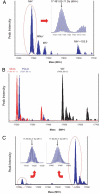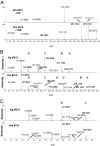Alternative Neisseria spp. type IV pilin glycosylation with a glyceramido acetamido trideoxyhexose residue
- PMID: 17804791
- PMCID: PMC1976187
- DOI: 10.1073/pnas.0705335104
Alternative Neisseria spp. type IV pilin glycosylation with a glyceramido acetamido trideoxyhexose residue
Abstract
The importance of protein glycosylation in the interaction of pathogenic bacteria with their host is becoming increasingly clear. Neisseria meningitidis, the etiological agent of cerebrospinal meningitis, crosses cellular barriers after adhering to host cells through type IV pili. Pilin glycosylation genes (pgl) are responsible for the glycosylation of PilE, the major subunit of type IV pili, with the 2,4-diacetamido-2,4,6-trideoxyhexose residue. Nearly half of the clinical isolates, however, display an insertion in the pglBCD operon, which is anticipated to lead to a different, unidentified glycosylation. Here the structure of pilin glycosylation was determined in such a strain by "top-down" MS approaches. MALDI-TOF, nanoelectrospray ionization Fourier transform ion cyclotron resonance, and nanoelectrospray ionization quadrupole TOF MS analysis of purified pili preparations originating from N. meningitidis strains, either wild type or deficient for pilin glycosylation, revealed a glycan mass inconsistent with 2,4-diacetamido-2,4,6-trideoxyhexose or any sugar in the databases. This unusual modification was determined by in-source dissociation of the sugar from the protein followed by tandem MS analysis with collision-induced fragmentation to be a hexose modified with a glyceramido and an acetamido group. We further show genetically that the nature of the sugar present on the pilin is determined by the carboxyl-terminal region of the pglB gene modified by the insertion in the pglBCD locus. We thus report a previously undiscovered monosaccharide involved in posttranslational modification of type IV pilin subunits by a MS-based approach and determine the molecular basis of its biosynthesis.
Conflict of interest statement
The authors declare no conflict of interest.
Figures




Similar articles
-
Genetic characterization of pilin glycosylation and phase variation in Neisseria meningitidis.Mol Microbiol. 2003 Aug;49(3):833-47. doi: 10.1046/j.1365-2958.2003.03602.x. Mol Microbiol. 2003. PMID: 12864863
-
Analysis of the role of pglI in pilin glycosylation of Neisseria meningitidis.FEMS Immunol Med Microbiol. 2004 May 1;41(1):43-50. doi: 10.1016/j.femsim.2004.01.002. FEMS Immunol Med Microbiol. 2004. PMID: 15094166
-
Identification of a novel gene involved in pilin glycosylation in Neisseria meningitidis.Mol Microbiol. 1998 Aug;29(4):975-84. doi: 10.1046/j.1365-2958.1998.00962.x. Mol Microbiol. 1998. PMID: 9767566
-
Methods in enzymology: O-glycosylation of proteins.Methods Enzymol. 2005;405:139-71. doi: 10.1016/S0076-6879(05)05007-X. Methods Enzymol. 2005. PMID: 16413314 Review.
-
The role of pilin glycan in neisserial pathogenesis.Mol Cell Biochem. 2003 Nov;253(1-2):179-90. doi: 10.1023/a:1026058311857. Mol Cell Biochem. 2003. PMID: 14619968 Review.
Cited by
-
Complete posttranslational modification mapping of pathogenic Neisseria meningitidis pilins requires top-down mass spectrometry.Proteomics. 2014 May;14(10):1141-51. doi: 10.1002/pmic.201300394. Epub 2014 Mar 12. Proteomics. 2014. PMID: 24459079 Free PMC article.
-
Characterization of the highly conserved VFMGD motif in a bacterial polyisoprenyl-phosphate N-acetylaminosugar-1-phosphate transferase.Protein Sci. 2012 Sep;21(9):1366-75. doi: 10.1002/pro.2123. Epub 2012 Aug 10. Protein Sci. 2012. PMID: 22811320 Free PMC article.
-
Sticky and sweet: the role of post-translational modifications on neisserial pili.Front Microbiol. 2011 Apr 27;2:87. doi: 10.3389/fmicb.2011.00087. eCollection 2011. Front Microbiol. 2011. PMID: 21779276 Free PMC article. No abstract available.
-
Genetic, Functional, and Immunogenic Analyses of the O-Linked Protein Glycosylation System in Neisseria meningitidis Serogroup A ST-7 Isolates.J Bacteriol. 2023 Mar 21;205(3):e0045822. doi: 10.1128/jb.00458-22. Epub 2023 Feb 28. J Bacteriol. 2023. PMID: 36852982 Free PMC article.
-
Type IV pilin proteins: versatile molecular modules.Microbiol Mol Biol Rev. 2012 Dec;76(4):740-72. doi: 10.1128/MMBR.00035-12. Microbiol Mol Biol Rev. 2012. PMID: 23204365 Free PMC article. Review.
References
Publication types
MeSH terms
Substances
LinkOut - more resources
Full Text Sources
Other Literature Sources
Miscellaneous

